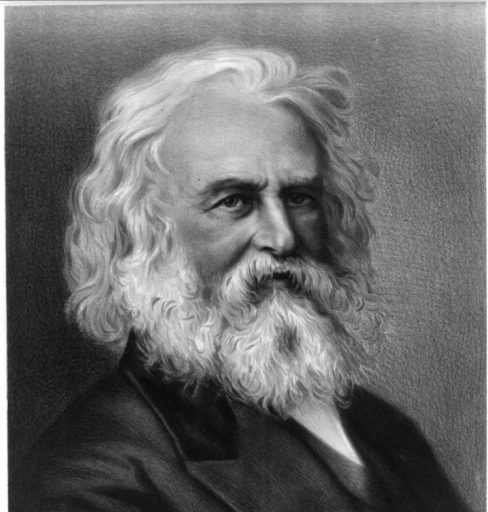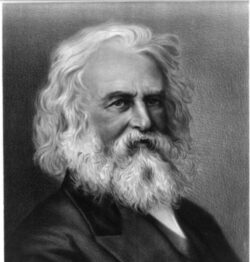Legend of Evangeline
The legend of a displaced Acadian couple, Evangeline has played an important role in Louisiana history and culture despite its fictional nature.

Courtesy of Library of Congress Prints and Photographs Division.
A black and white reproduction of a head and shoulders portrait of Henry Wadsworth Longfellow, who wrote Evangeline: A Tale of Acadie, in 1847.
Inspired by Henry Wadsworth Longfellow’s 1847 poem, the legend of Evangeline—a displaced Acadian mourning her lost love—has played an important role in Louisiana history and culture. Despite the fictional nature of the poem, Evangeline and her story became symbols of the le grand dérangement, the expulsion of Acadians from what is now Nova Scotia between 1755 and 1763. Many of these Acadian exiles eventually settled in Louisiana, where, over time, they developed a unique Cajun culture. Though well known outside the state, the legend of Evangeline plays a particularly central role in Louisiana culture, where it is often presented as a factual rather than poetic expression of an historical event.
Longfellow’s Poem
Longfellow’s poem Evangeline: A Tale of Acadie (1847) tells the story of Evangeline Bellefontaine and Gabriel Lajeunesse, two young people separated at the time of the Acadian exile. As the British begin deporting Acadians from their ancestral homeland, the young lovers are torn apart on their wedding day. Evangeline travels with a group of exiles to Louisiana, only to find that Gabriel had been there but moved elsewhere. She finally finds him many years later on his deathbed in Philadelphia, and the two share a final kiss as he dies.
According to most accounts, Longfellow heard the story from Horace Lorenzo Conolly, a native of Maine who became rector of St. Matthew’s Episcopal Church in Boston, Massachusetts. He passed it on to Longfellow’s friend, writer Nathaniel Hawthorne, who wrote in his notebook that Conolly, “had heard from a French Canadian the story of a young couple in Acadia.” In May 1844, Hawthorne had Conolly tell the story to Longfellow when the three were at a dinner party at Longfellow’s home. The story captured Longfellow’s imagination, and he wrote the tale of Evangeline and Gabriel in the form of a poem.
Though Longfellow never visited Louisiana, he consulted histories such as Thomas C. Haliburton’s An Historical and Statistical Account of Nova Scotia. He did not, however, intend for his poem to be taken as a factual account. Indeed, even if he had, the history he used was seriously flawed in the eyes of modern scholars. Despite some criticism, publication of the poem was a major literary event. Five editions of one thousand copies each sold out in the first year of its publication. During the next century, the poem went through more than 250 editions and was translated into more than 125 languages.
Felix Voorhies’s Novel
Despite the fictional nature of Longfellow’s poem, in Louisiana the legend of Evangeline began to take on a life of its own. Historian Carl A. Brasseaux suggests that “growing credence in the Evangeline story, and thus in the historicity of its characters, was fostered by Longfellow’s literary successors, particularly Felix Voorhies, whose works were also intended to be purely fictional.” In his 1907 novelette, Acadian Reminiscences: The True Story of Evangeline, Voorhies tells the tale of Emmeline Labiche and Louis Arceneaux, who tried to flee from the village of St. Gabriel in old Acadia. They were caught by the British and sent their separate ways. According to the Voorhies story, Emmeline was among a group of Acadians sent to Maryland who eventually came to Louisiana. These Acadians finally reached Voorhies’s hometown of St. Martinville, where long-lost friends and relatives greeted them.
While Voorhies, like Longfellow, wrote fiction, other writers consistently suggested that the fictional accounts of Evangeline were accurate historical narratives, at least in part. “Capitalizing upon the romantic aspect of the work,” Brasseaux argues, popular writers repeatedly embellished the story, creating “a legend which bore only a faint resemblance to the original story line and none to historical events.” Adding to the legend’s complexity and tenacity were films, plays, sheet music, and other novels inspired by the story of Evangeline.
The Legend in Louisiana
Something like the Evangeline tale probably did happen to a pair of Acadian sweethearts, and perhaps to more than one pair. But there is no record that anyone named Evangeline Bellefontaine, Gabriel Lajeunesse, or Emmeline Labiche lived in Acadia at the time of the exile. There was a real Louis Arceneaux, but he was born in St. James Parish thirteen years after the Acadian exile. While several southern Louisiana families claim that the characters portrayed in the poem were based on their ancestors, none of these claims can be substantiated. Still, many Acadians and Louisianians continue to regard the legend of Evangeline as a kind of historical evidence or truth. To them, the legend is as an accurate assessment of the Acadian people’s ability to endure an exile designed to destroy them as a cohesive ethnic group.
Economic motives also helped keep the legend alive. Voorhies’s version of the story was set in St. Martinville, and the town quickly utilized the myth to lure visitors. An Evangeline statue sits next to the town’s historic Catholic church, while the two-hundred-year-old Evangeline Oak draws tourists to the banks of Bayou Teche. Just north of St. Martinville sits the Longfellow-Evangeline State Historic Site, and the names of numerous local businesses and organizations reflect the legend’s tenacity. In 1929, United Artists turned the story into a popular and profitable movie, Evangeline. Actress Dolores Del Rio, who played Evangeline in the film, even provided the model for the bronze statue in St. Martinville.
Taken as fact or enjoyed as fiction, the legend of Evangeline has undeniably played an important role in Louisiana, especially Cajun, culture. The legend helped marginalized Acadians—wherever they landed—maintain a sense of cultural identity. In Louisiana, the legend inadvertently gave Acadians an origin or creation myth. Yet, as Carl Brasseaux has pointed out, it is a “flawed one since it originated outside of the culture instead of developing within as the folks themselves sought self-definition.”
